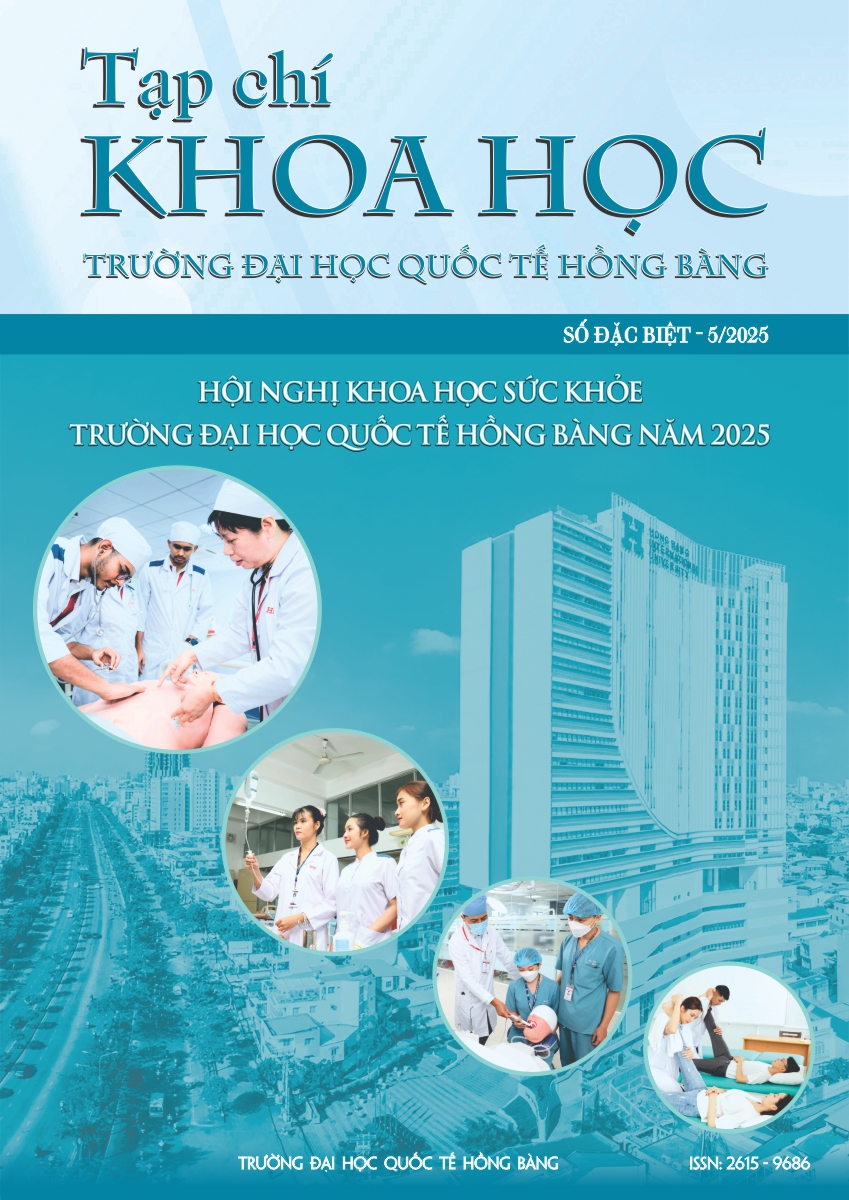CĂNG THẲNG Ở NGƯỜI CHĂM SÓC BỆNH NHÂN SA SÚT TRÍ TUỆ TRONG THỜI KỲ DỊCH COVID-19 Ở VIỆT NAM
Các tác giả
DOI: https://doi.org/10.59294/HIUJS.KHSK.2025.006Từ khóa:
căng thẳng, người chăm sóc, sa sút trí tuệ, COVID-19Tóm tắt
Đặt vấn đề: Căng thẳng đối với người chăm sóc bệnh nhân sa sút trí tuệ là một trong những vấn đề thời sự và nhận được sự quan tâm lớn của xã hội. Trong đại dịch COVID-19, người chăm sóc lại càng đối mặt với mức độ căng thẳng cao hơn do nhiều yếu tố tác động tiêu cực. Mục tiêu nghiên cứu: So sánh mức độ căng thẳng của người chăm sóc trước và trong đại dịch COVID-19, xác định các lý do gây căng thẳng và các phương pháp đối phó với căng thẳng. Kết quả: Điểm trung vị trên thang đo căng tăng 2 điểm trong đại dịch COVID-19 (95% CI: 0.5 đến 2.5; p < 0.05). Có nhiều lý do gây căng thẳng bao gồm các triệu chứng về nhận thức, trí nhớ và tâm thần kinh ở người bệnh sa sút trí tuệ trở nặng, lo lắng bị nhiễm bệnh; tình trạng thiếu thuốc điều trị và thiếu hỗ trợ y tế do dịch vụ y tế bị gián đoạn cũng như nỗi lo về các hậu quả có thể xảy ra trong thời kỳ hậu COVID-19. Người chăm sóc sử dụng nhiều biện pháp đối phó với căng thẳng bao gồm giải trí, thể dục thể thao, ăn uống lành mạnh, sử dụng thuốc và thực phẩm chức năng, các phương pháp y học cổ truyền, v.v. Kết luận: Người chăm sóc bệnh nhân sa sút trí tuệ có mức độ căng thẳng tăng lên rõ rệt trong thời kỳ đại dịch so với trước đó. Nguyên nhân gây căng thẳng rất đa dạng và các chiến lược đối phó với căng thẳng cũng phong phú.
Abstract
Introduction: Stress among caregivers of people with dementia is a critical social concern that has garnered increasing attention. During the COVID-19 pandemic, caregivers experienced elevated stress levels due to multiple compounding factors. Research Objectives: This study aimed to compare caregivers' stress levels before and during the COVID-19 pandemic, identify the underlying causes of stress, and explore the coping strategies employed. Results: The median score on a 10-Point Stress Scale increased by 2 points during the COVID-19 pandemic (95% CI: 0.5 to 2.5; p < 0.05). Several major stressors were identified, including worsening cognitive, memory, and neuropsychiatric symptoms in individuals with dementia; fear of COVID-19 infection; medication shortages; reduced access to healthcare services; and concerns about long-term post-COVID effects. Caregivers reported using a variety of coping strategies, such as engaging in recreational activities, physical exercise, healthy eating, the use of medications and dietary supplements, and traditional medicine approaches. Conclusion: Caregivers of people with dementia experienced a significant increase in stress during the COVID-19 pandemic compared to the pre-pandemic period. Stressors were diverse and multifactorial, and caregivers adopted various strategies to cope with the challenges.
Tài liệu tham khảo
[1] D. T. T. Thuy and others, “Prevalence of dementia among the elderly and health care needs in an urban community of central Vietnam.” 2015. [Online]. Available: https://www.researchgate.net/publication/280728275 Ngày truy cập 04/05/2025
[2] W. H. Organization, “COVID-19 and the care of older people with cognitive impairment: Policy Brief,” WHO, Geneva, 2020.
[3] R. S. Lazarus and S. Folkman, Stress, Appraisal, and Coping. New York: Springer, 1984.
[4] M. Altieri and G. Santangelo, “The psychological impact of COVID-19 pandemic and lockdown on caregivers of people with dementia,” Am. J. Geriatr. Psychiatry, vol. 29, no. 1, pp. 27-34, 2021, doi: 10.1016/j.jagp.2020.10.009.
DOI: https://doi.org/10.1016/j.jagp.2020.10.009[5] N. T. T. Mai and P. M. Thái, “Mức độ lo âu, trầm cảm của người chăm sóc bệnh nhân sa sút trí tuệ tại Việt Nam trong bối cảnh COVID-19,” Tạp Chí Nghiên Cứu Y Học, vol. 69, no. 4, pp. 121-128, 2022.
[6] M. Q. Patton, Qualitative Research and Evaluation Methods, 4th ed. Thousand Oaks, CA: Sage Publications, 2015.
[7] J. Green and N. Thorogood, Qualitative Methods for Health Research, 4th ed. London: SAGE Publications, 2018.
[8] A. Wutich, M. Beresford, and H. Bernard, “Sample Sizes for 10 Types of Qualitative Data Analysis: An Integrative Review, Empirical Guidance, and Next Steps,” Int. J. Qual. Methods, vol. 23, Oct. 2024, doi: 10.1177/16094069241296206.
DOI: https://doi.org/10.1177/16094069241296206[9] Qualtrics, “Your quick guide to open-ended questions in surveys.” Accessed: May 04, 2025. [Online]. Available: https://www.qualtrics.com/en-au/experience-management/research/open-ended-questions/ Ngày truy cập 04/05/2025
[10] K. M. Harris, A. E. Gaffey, J. E. Schwartz, D. S. Krantz, and M. M. Burg, “The Perceived Stress Scale as a Measure of Stress: Decomposing Score Variance in Longitudinal Behavioral Medicine Studies.,” Ann. Behav. Med. Publ. Soc. Behav. Med., vol. 57, no. 10, pp. 846-854, Sep. 2023, doi: 10.1093/abm/kaad015.
DOI: https://doi.org/10.1093/abm/kaad015[11] N. T. Bình, “Đặc điểm lâm sàng và gánh nặng chăm sóc cho bệnh nhân Alzheimer giai đoạn nặng,” Luận án tiến sĩ, Đại học Y Hà Nội, 2018.
[12] N. B. Ngọc, “Đánh giá gánh nặng của người chăm sóc trong bệnh Alzheimer,” Học Dự Phòng, vol. 5, no. 141, pp. 88-94, 2013.
[13] Alzheimer’s Association, “2021 Alzheimer’s disease facts and figures,” Alzheimers Dement., vol. 17, no. 3, pp. 327-406, 2021, doi: 10.1002/alz.12328.
DOI: https://doi.org/10.1002/alz.12328[14] N. N. Ánh and Đ. T. K. Hỷ, “Nghiên cứu gánh nặng chăm sóc bệnh nhân Alzheimer tại Bệnh viện Lão khoa trung ương năm 2020 - 2021,” Tạp Chí Y Học Việt Nam, vol. 503, no. 1, Aug. 2021, doi: 10.51298/vmj.v503i1.736.
DOI: https://doi.org/10.51298/vmj.v503i1.736[15] F. C. Alliance, “Caregiver Statistics: Work and Caregiving,” Family Caregiver Alliance. Accessed: Mar. 20, 2025. [Online]. Available: https://www.caregiver.org/resource/caregiver-statistics-work-and-caregiving/
[16] “Dementia in Australia, Carers of people with dementia,” Australian Institute of Health and Welfare. Accessed: Mar. 20, 2025. [Online]. Available: https://www.aihw.gov.au/reports/dementia/dementia-in-aus/contents/carers-and-care-needs-of-people-with-dementia
[17] M. C. N. Dourado et al., “COVID-19: challenges for dementia care and research.,” Dement. Neuropsychol., vol. 14, no. 4, pp. 340-344, Dec. 2020, doi: 10.1590/1980-57642020dn14-040002.
DOI: https://doi.org/10.1590/1980-57642020dn14-040002[18] H. Brodaty and M. Donkin, “Family caregivers of people with dementia.,” Dialogues Clin. Neurosci., vol. 11, no. 2, pp. 217-228, 2009, doi: 10.31887/DCNS.2009.11.2/hbrodaty.
DOI: https://doi.org/10.31887/DCNS.2009.11.2/hbrodaty[19] A. C. Damian et al., “Caregiving for Dementia Patients during the Coronavirus Pandemic.,” J. Clin. Med., vol. 12, no. 7, Mar. 2023, doi: 10.3390/jcm12072616.
DOI: https://doi.org/10.3390/jcm12072616[20] Z. xu, A. Elomri, L. Kerbache, and A. EL Omri, “COVID-19s impacts on Global Supply Chains: Facts and Perspectives,” IEEE Eng. Manag. Rev., vol. PP, pp. 1-1, Aug. 2020, doi: 10.1109/EMR.2020.3018420.
[21] Y. Fu et al., “The effect of mindfulness meditation on depressive symptoms during the COVID-19 pandemic: a systematic review and meta-analysis.,” Sci. Rep., vol. 14, no. 1, p. 20189, Aug. 2024, doi: 10.1038/s41598-024-71213-9.
DOI: https://doi.org/10.1038/s41598-024-71213-9[22] R. G. Malapela, G. Thupayagale-Tshweneagae, and W. M. Baratedi, “Use of home remedies for the treatment and prevention of coronavirus disease: An integrative review.,” Health Sci. Rep., vol. 6, no. 1, p. e900, Jan. 2023, doi: 10.1002/hsr2.900.
DOI: https://doi.org/10.1002/hsr2.900Tải xuống
Tải xuống: 123











